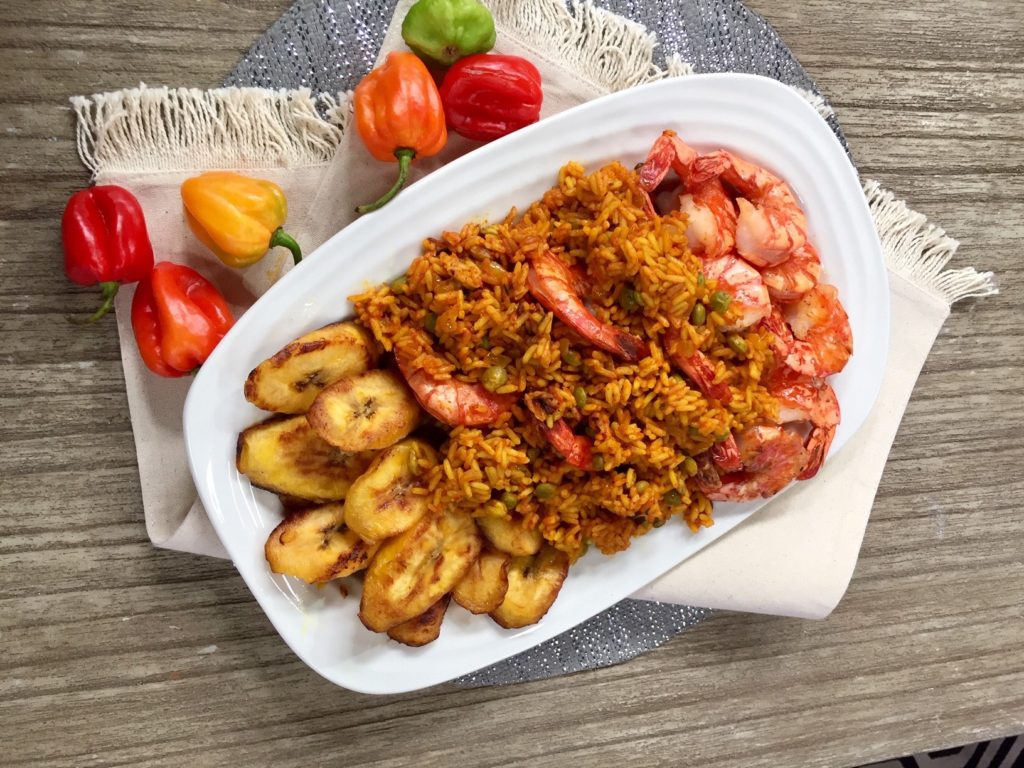
Jollof rice is a staple dish all over West Africa. Also
known as “party rice”, it’s the something you can expect at any celebration, in
every household. It’s packed with flavour and starts with the traditional tomato
stew that is the base of so many other regional dishes. Developing this recipe
was challenging, I must admit, but I’m happy for the experience because
now I've got this wicked technique for creating amazingly flavourful rice pilafs to keep in my back pocket. It’s the perfect thing to serve for a
party because it’s rich, colourful, and anything but boring. I added pigeon peas and creamed coconut to add a little Caribbean flair to this dish simply because I can, and it reminds me of the pelaus my mom used to make. Bonus: it’s also
vegan-friendly if you use a vegetable stock cube rather than chicken. The key
to nailing it is using parboiled long grain rice, and while I
certainly have thorough recipe instructions below, I feel it imperative to also mention
that, as in my mother’s kitchen, you should never make rice without a cup of
water beside you at the stove. You see, there are many factors that affect heat and moisture levels when you’re cooking and rather than blindly
following a recipe to the letter, it’s much wiser to pay close
attention to the way things are working on your
stove. Recipes are essentially guidelines, after all. When you’re making jollof
rice (or any rice for that matter), be sure to take a quick peek around the 10-15-minute
mark and check if things are drying out too quickly. If that’s the case, a
little splash or two of water from the aforementioned cup beside your stove
will be the saving grace you need.
Serves 6, or more
Ingredients
| 2 | plum tomatoes, quartered |
| 1 | red bell pepper, seeded, roughly chopped |
| 1/2 | scotch bonnet pepper, seeds removed |
| 1-inch piece | fresh ginger, peeled |
| 2 cloves | garlic, peeled |
| 1/4 cup | canola oil |
| 1/4 tsp | sea salt |
| 1 | red onion, diced small |
| 3 Tbsp | tomato paste |
| 2 1/2 tsp | Caribbean curry powder |
| 1 | stock cube (11.5 g, preferably chicken) |
| 1/2 tsp | dried thyme |
| 1 | bay leaf, fresh or dried |
| 1-1/2 cups | parboiled long-grain rice, rinsed well until water is clear |
| water | |
| 1 cup | pigeon peas (frozen, or canned and drained) or red kidney beans (canned and drained), optional |
| 2 tsp | coconut cream (in brick from from a Caribbean grocer) |
| 1 | plantain, ripe to the point where the skin is mostly black, peeled and sliced canola oil, for frying |
| canola oil, for frying |
Directions
To a blender add all ingredients from tomatoes to garlic. Blend until smooth and set aside. Should yield about 2 cups of puree.
Heat a medium-sized heavy-bottom saucepan over medium-low heat; make sure it’s one that has a tight-fitting lid because you’ll need that later. Add the canola oil, salt, and red onion. Sweat until soft and translucent, about 3 minutes – this gently coaxes out their sweetness.
- Add the tomato paste and curry powder, increase the heat to medium, and cook while stirring often, about 3 minutes. *This is to remove the bitter, metallic taste of the tomato paste while simultaneously toasting the curry spices, and are necessary steps in any recipe using either of these two ingredients - just a heads up.
- Add the purée, stock cube, thyme, and bay leaf. Cover partially with lid and simmer 20 minutes until thick and reduced. Stir often to prevent any scorching on the bottom of the pot, and be sure to cover partially with the lid because the sauce is going to splatter. After 20 minutes it'll be reduced to about 1 cup.
- Transfer reduced purée to a large measuring cup and add enough water for the total volume to reach the 3-1/4 cup mark. Add this liquid back to the saucepan and bring to a boil. Once boiling add the rinsed rice, pigeon peas (if using), and coconut cream. Reduce heat to low, cover completely with the lid, and simmer 20-25 minutes until rice is fluffy and cooked through. Don't forget to peek at your rice at the 10-15 minute mark to check the moisture content, as I mentioned above.
- Meanwhile, heat a layer of canola oil over medium in a non-stick frying pan. Use a small piece of plantain to test if the oil is at the right temperature: it’s frying time when there are small, rapidly moving bubbles kissing the test piece of plantain. Fry in batches about 1 minute per side until deeply golden brown and transfer to a paper towel lined plate. The sugars in the plantain caramelize quickly, so be mindful of your stove temperature and be sure not to overcrowd the pan.
- To serve, remove the bay leaf and transfer hot rice to a platter. Garnish with fried plantains placed around the perimeter. This dish is naturally protein-rich thanks to the combo of rice and peas, but feel free to add simply cooked proteins, like sauteed shrimp, if you choose.




